Repair of Concrete Structures under Construction
By Bud Earley
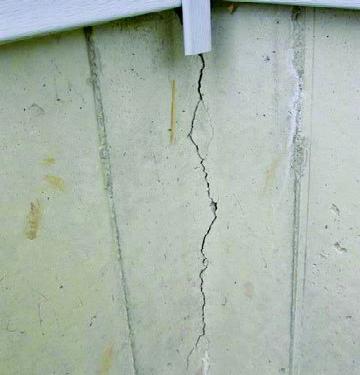 |
| Cracks not Addressed |
One might think that concrete repair is limited to existing structures that have matured or aged prematurely with help from Mother Nature or other outside influences. If we take a closer look at newer construction, we will see that there are a considerable number of structures in need of concrete repair.
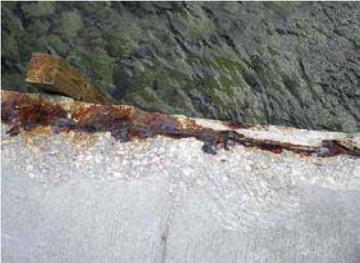 |
| Eventually Lead to Severe Damage and Extensive Repairs |
If concrete is the most durable and widely used construction material in the world today, why does it seem to go bad so quickly? Two probable reasons for this are 1) inflicted causes; and 2) environ mental causes.
1. Inflicted causes are problems created by human error. For example:
- Low concrete strength: If too much water is added at the batch plant or on site to improve workability, the strength of concrete will suffer;
- Inadequate concrete cover: Sometimes rein forcement steel may not be secured properly. It may move during placement of the concrete, or the forms may move, causing the steel to lean against the form with only a thin layer of cement paste covering it;
- Poor construction techniques: Education in industry best practice is vital to successful projects. Often, the people being trained are not the ones completing the task. Sometimes some thing as simple as where to place the welded wire mesh (WWM) in a slabonground can be overlooked; and
- Specifications: Unclear specifications can lead to mistakes in the field. Sometimes old habits are hard to break; and if a change is not clearly defined, misinterpretations can lead to costly mistakes.
2. Environmental causes are problems created by the environment:
- Cold weather: freezing and thawing and the limiting effects of cold conditions;
- Hot weather: earlydrying shrinkage and the limiting effects of hot conditions;
- Chemical attack: material degradation as a result of chemical agents such as bases, salts, and moisture; and
- Carbonation: the conversion of calcium ions in hardened cementitious materials to calcium carbonate by reaction with atmospheric carbon dioxide.
These causes can lead to problems such as cracking,curling, honeycombs, or voids.
Concrete Cracking
Concrete contracts and expands with changes in moisture content and temperature, and it deflects depending on load and support conditions. There are many different forms of cracking to deal with on a daily basis. Some of the more common types of cracks are plastic shrinkage (which appear on the surface of freshly placed concrete during finishing or soon after), drying shrinkage (shrinkage tendency is increased by drying and/or a drop in temperature and can lead to random cracking), and settlement (nonuniform support of footings or occasionally from expansive soils).
Poor cover over reinforcement leads to carbon ation and chloride attack. When ignored, this too can lead to more serious problems with corrosion.
Cracking can also result from others causes:
- Improper joint spacing;
- Poorly prepared subgrade;
- Structural overload;
- Disruption from expansive aggregate; and
- Disruption from corrosion of reinforcement.
Poor Construction Techniques
Lack of supervision on any given day can lead to something small being overlooked or something major not being noticed until it's too late. As mentioned previously, untrained and/or unsuper vised personnel can create a major headache when you least expect it.
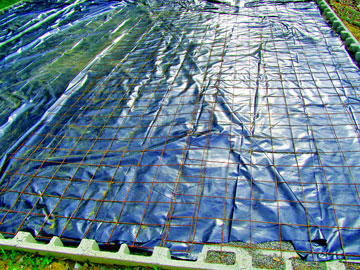 |
|
Welded wire mesh is basically used in a slab to help cracking. If the mesh is placed under the vapor barrier as seen here, it serves no purpose and the slab-on-ground will most surely crack
|
Vapor barriers immediately under the concrete may aggravate plastic and drying shrinkage cracking and slab curling because the bottom of the slab loses little or no moisture while the top dries and shrinks at a faster rate.
Concrete Curling
Curling is the distortion of a slab into a curved shape by upward or downward bending of the edges. Distortion can lift edges of the slab from the base leaving an unsuspended edge or corner that can crack when heavy loads are applied.
Honeycombs/Voids
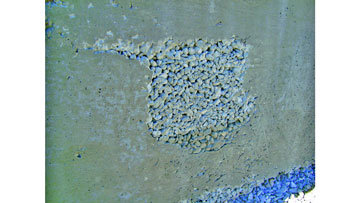 |
| Honeycombs / Voids |
Honeycombs and voids in concrete are created when the mortar does not fill all of the spaces between the coarse aggregate particles. This is occurring more frequently because of the changes in structural design and the need to change the concrete mixture design to suit the requirements of the specifications.
Repairing Cracks in Concrete
Before you begin to repair cracks in concrete, you should answer the question: "What is the purpose of this crack repair?" For example, do you want to achieve structural integrity, focus on aesthetics, seal against intrusion of foreign materials, protect against carbonation, protect against chloride and water ingress; and/or seal in preparation for additional topping material?
Table 1: Tolerable crack widths (ACI 224 [4.4] Table 4.1)
|
Exposure condition
|
Tolerable crack width |
| in. |
mm |
| Dry air or protective membrane |
0.016 |
0.41 |
| Humidity, moist air, soil |
0.012 |
0.30 |
| Deicing chemicals |
0.007 |
0.18 |
| Seawater and seawater spray: wetting and drying |
0.006 |
0.15 |
| Waterretaining structures, excluding nonpressure pipes |
0.004 |
0.10 |
Hairline cracks are often ignored because they are thought of as nonstructural and, therefore, not a threat to the integrity of the structure. As stated previously, if left untreated, hairline cracks will eventually become larger and lead to more costly repairs.
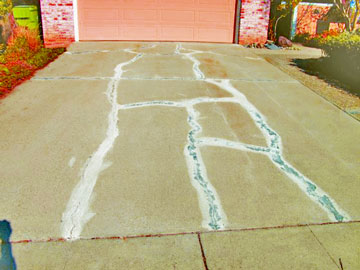 |
| Unsightly crack |
As with all concrete repairs, it is important to identify the cause of the crack. The most common causes of cracking in concrete are settlement, shrinkage, dynamic load, inadequate joint design or spacing, and corrosion.
Flexible sealants and crack fillers are used to seal against intrusion of foreign materials directly into the crack but can often become unsightly. Flexible sealants and crack fillers are used to detail cracks prior to the application of an elastomeric membrane. This process hides the crack repair, providing a more uniform and aesthetically pleasing finish. All cracks will have a small percentage of movement due to temperature change. Because cemen titious mortars cannot bridge moving cracks successfully, they should not be used as a crack repair. Until the development and acceptance of epoxy resin injection, most crack repair methods were considered temporary. Epoxies can be used on horizontal, vertical, and overhead applications. Horizontal cracks can be easily filled using the gravity feed method. After proper cleansing of the crack, the epoxy resin is simply allowed to puddle over the crack and soak in until filled.
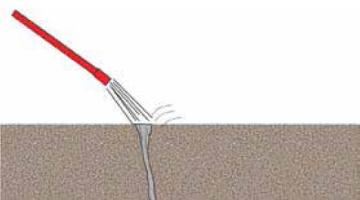 |
| Blow Out Crack With Oil-Free Compressed Air |
The preparation of cracks is still a topic of debate. Care needs to be taken in the method of surface prep with cracks. Crack chasing and saw cutting cracks are popular but could pack fines into the crack and block the flow of resin. It is recom mended to blow out cracks with oilfree compressed air. This has proven to be the most successful method of crack repair preparation.
For vertical and overhead applications, injection of epoxy resins in concrete has proven to be one of the more permanent methods of repair.
Repairs to Curled Slabs
Curling is where greater shrinkage has occurred on the top of the slab than on the bottom of the slab resulting in the edges of the slab curling upward. This can also cause voids to occur under the slab. Whether this occurs at joints, cracks, or at the slab edges, it is usually necessary to grind the curled edge high points to ensure a level floor surface. The joints and cracks then need to be prepared and filled with the proper materials selected on the basis of the slab usage and location.
If there is significant curling, it may be necessary to core holes at approximately 30 in. (76 cm) on center, alternating each side of the joint or crack to fill the void under the slab.
Repairing Honeycombs/Voids
Although ICRI Technical Guideline No. 03730 is designed with horizontal repairs in mind, it is also suitable for voids in a vertical application dealing with honeycombs or voids. Voids often occur because aggregate is too large to pass through a condensed area of reinforcement. When forms are removed, large areas without concrete need to be filled.
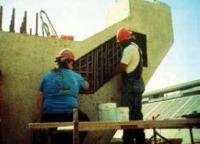 |
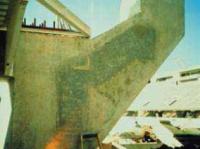 |
| Cementitious Concrete Repair Mortar Applications |
Product features for filling voids usually include:
- Pourable and/or pumpable;
- Preextended with aggregate for deep repairs (up to 6 in. [15 cm]); and
- Capable of flowing to all areas within the form with little to no vibration required.
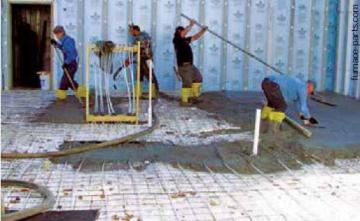 |
| Poor Construction Techniques |
Avoiding Problems in the Future
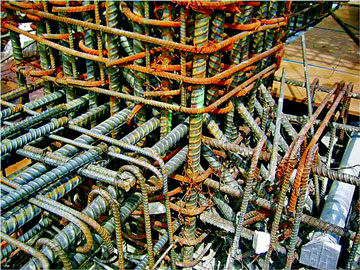 |
| Congested Reinforcement |
One of the best practices in avoiding many mistakes with concrete in new construction is to start with a good concrete specification. Concrete quality requirements include but may not be limited to:
- Watercementitious ratio: the critical factor in many concretes for watertightness and durability;
- Combined aggregate gradation;
- Air content: mandatory in certain concretes and a significant negative in others;
- Slump: the use of waterreducing admixtures can provide the optimum concrete for most projects;
- Steel and/or synthetic fibers: beneficial in reducing cracking and extending joint spacing; and
- Adherence to industry best practice guidelines, that is, ACI 302.1R04: understand the key points of joint design and spacing.
Reduce slab curling by equalizing moisture content and temperature between the top and bottom of the slab. Be sure to use concrete with low shrinkage characteristics. Use a permeable (porous) base. Cure the slab well, particularly during the early stages after placement. Understand the para meters by which a vapor barrier is used. Be aware of moisture sensitive flooring products that will be placed over the slab when the structure in put in use.
New construction honeycomb/congested reinforcement. Why didn't a standard mixture work here?
Become familiar with new technology admixtures that are available. When there are congested areas of reinforcement or a substantial distance for the concrete to be pumped or travel within the forms, use a selfconsolidating concrete mixture.
Avoiding poor construction techniques. Where's the mesh?
A fastgrowing technology is the use of macro fibers for replacement of WWM for slabonground construction. They eliminate having the mesh simply rest on the bottom of the slab, tripping hazards over the mesh (safety), the mistake of placing it in the wrong location (cost of replacement), and fibers are a costeffective substitute for WWM.
Unlike conventional reinforcement, fibers are evenly distributed throughout the concrete element.
Fiber-reinforced concrete promotes better control of crack formation and propagation
Highquality, highperformance concrete is being placed daily. All owners want a uniform dense troweled surface with minimal cracking, curling, and no voids! An awareness of building code requirements for reinforced concrete is critical to a successful concrete placement on new construction. Understanding the key requirements of ACI302.1R04 and the various advances in concrete technology, that is, selfconsolidating concrete and structural macrofibers are just a few things we can do to reduce the number of "Repairs of Concrete Structures under Construction."
Author
 |
Bud Earley, FICRI, CSI, CDT, is a National Business Development Manager for The Euclid Chemical Company. He has over 30 years of experience in concrete restoration, repair, and protection. He serves on ICRI's Board of Directors and the Technical Activities Committee (TAC), and is Co-Chair of the Education Committee. Earley is a member of the Construction Specifications Institute (CSI) and is certified as a Construction Documents Technologist (CDT). He can be reached at (800) 321-7628 or via e-mail at bearley@euclidchemical.com. |